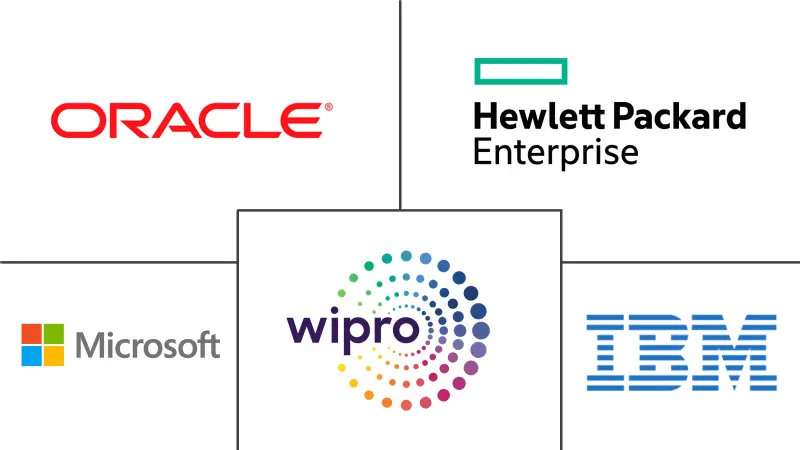Enterprise AI Market Size and Share
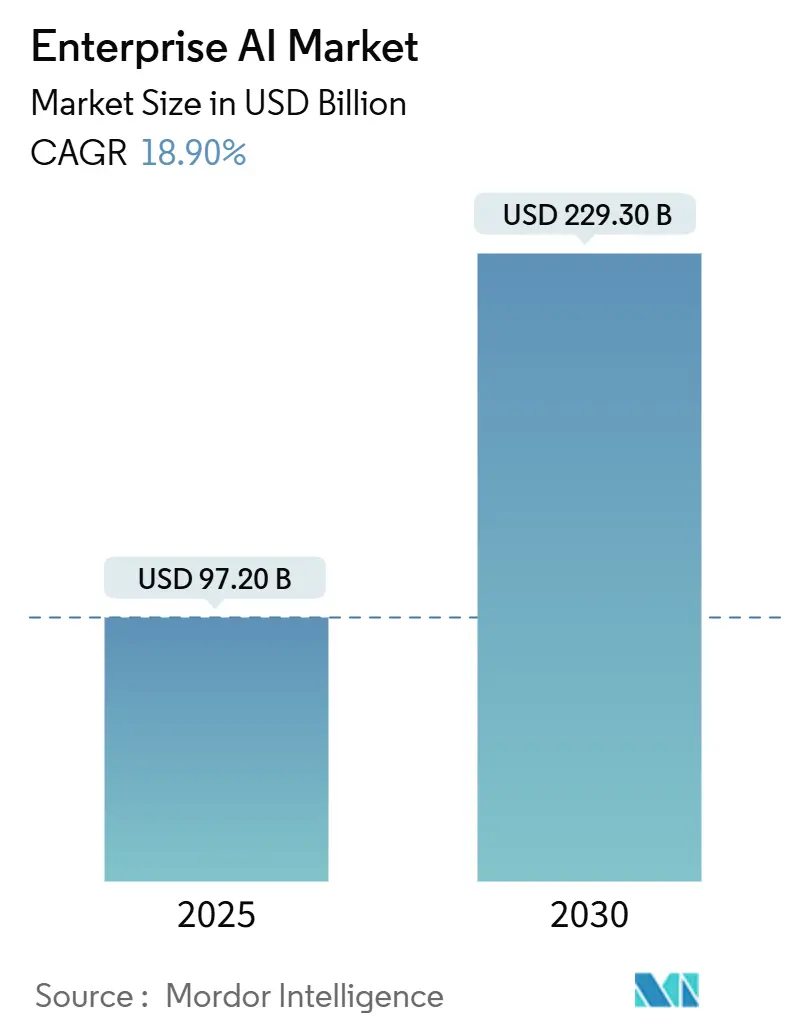
Enterprise AI Market Analysis by Mordor Intelligence
The enterprise AI market size is estimated at USD 97.2 billion in 2025 and is forecast to reach USD 229.3 billion by 2030, registering an 18.9% CAGR. Expansion is propelled by rapid adoption of generative AI, agentic systems that automate multi-step tasks, and rising demand for specialised silicon that cuts inference times. Enterprises increasingly view AI as a route to cost optimisation, with Microsoft’s AI portfolio alone running at a USD 13 billion annualised rate in fiscal 2025, a 175% year-on-year jump. Hardware suppliers mirror this momentum; NVIDIA posted USD 44.1 billion in Q1 FY2026 revenue despite export controls, underlining resilient demand for high-end GPUs. Cloud remains the primary deployment path, yet hybrid and edge rollouts are climbing fast as firms juggle data-sovereignty mandates with real-time use cases. Investment patterns hint at a maturing competitive environment: venture capital funding topped USD 100 billion in 2024, but deals are concentrating around fewer late-stage players, signalling future consolidation.
Key Report Takeaways
- By component, software and platforms led with 48% revenue share in 2024; hardware accelerators are advancing at a 23.11% CAGR through 2030.
- By organization size, large enterprises led with a 57.32% revenue share in 2024; small and Medium Enterprises are advancing at a 21.89% CAGR through 2030.
- By functional area, operations and supply-chain led with a 41.83% revenue share in 2024 and are expected to advance at a 20.53% CAGR through 2030.
- By technology, machine learning models led with a 45.79% revenue share in 2024; Computer Vision is expected to advance at a 20.67% CAGR through 2030.
- By end-user industry, BFSI held 21.30% of the enterprise AI market size in 2024; healthcare is projected to grow at a 22.17% CAGR to 2030.
- By deployment model, cloud accounted for 69% of the enterprise AI market share in 2024, while hybrid and edge configurations are projected to expand at a 24.05% CAGR to 2030.
- By geography, North America captured 41.50% revenue share in 2024; the Middle East and Africa region is forecast to rise at 21.70% CAGR through 2030.
Global Enterprise AI Market Trends and Insights
Drivers Impact Analysis
| Driver | (~) % Impact on CAGR Forecast | Geographic Relevance | Impact Timeline |
|---|---|---|---|
| Surging demand for automation and AI-based solutions | +4.2% | Global, with concentration in North America and Europe | Medium term (2-4 years) |
| Need to analyse exponentially growing enterprise data sets | +3.8% | Global, led by Asia-Pacific and North America | Long term (≥ 4 years) |
| Rise of cloud-based AI-as-a-Service platforms | +3.1% | North America and EU, expanding to Asia-Pacific | Short term (≤ 2 years) |
| Advances in specialised computing hardware (GPU, TPU, NPU) | +2.9% | Global, supply concentrated in Taiwan and South Korea | Medium term (2-4 years) |
| Industry-specific foundation models democratising AI for SMEs | +2.2% | Asia-Pacific core, spill-over to MEA and Latin America | Long term (≥ 4 years) |
| Net-Zero pledges driving AI-enabled carbon-optimisation tools | +1.8% | EU and North America, expanding globally | Long term (≥ 4 years) |
| Source: Mordor Intelligence | |||
Surging Demand for Automation and AI-Based Solutions
Corporate automation has moved beyond rule-based RPA toward cognitive agents spanning supply chain, finance, and customer operations. Organizations that embed agentic AI in logistics report 61% higher revenue growth than peers, while manufacturers such as Unilever lifted overall equipment effectiveness by 85% through AI-driven optimisation. Decision cycles that once took days now shrink to minutes, delivering not just cost control but faster market response. Coupling generative AI with workflow engines is spawning adaptive process automation that refines itself without human scripting. [1]IBM, “Scaling Supply Chain Resilience: Agentic AI for Autonomous Operations,” ibm.com
Need to Analyse Exponentially Growing Enterprise Data Sets
Data growth outpaces traditional analytics tooling, creating pent-up demand for large-language-model interfaces that let business users query multi-petabyte stores in natural language. Financial firms deploy GPT-scale models to combine transactions, chat transcripts, and market feeds for in-flight risk scoring, while healthcare providers synthesise imaging and EHR records to support diagnostics. Automated data-discovery features in modern AI stacks now cut data-prep effort from months to days, unlocking value faster.
Rise of Cloud-Based AI-as-a-Service Platforms
Public-cloud vendors have pivoted from generic compute to vertically integrated AI launches. AWS logged USD 29.3 billion Q1 2025 revenue, powered by more than 1,000 generative-AI projects in development. Google Cloud’s 28% top-line growth reflects traction for domain-tuned foundation models and in-house TPUs that lower cost per inference. Pay-as-you-go access lets mid-tier firms join the enterprise AI market without capital-intensive clusters, fuelling broader diffusion.
GPU Scarcity Spurs Surge in NPUs and Alternative Accelerators
Persistent GPU scarcity led H100 prices to triple, driving CIOs toward alternative accelerators such as AMD MI300 and purpose-built NPUs that deliver higher inference efficiency. The NPU category is forecast to expand at 35% CAGR toward USD 100 billion by 2030. Cloud providers now package custom silicon into their stacks, and CHIPS Act funding is funnelling USD 8.5 billion into new US fabs to ease future constraints.
Restraints Impact Analysis
| Restraint | (~) % Impact on CAGR Forecast | Geographic Relevance | Impact Timeline |
|---|---|---|---|
| Cultural and skills gap slowing enterprise adoption | -2.8% | Global, acute in traditional industries | Medium term (2-4 years) |
| Data-sovereignty and privacy-regulation hurdles | -2.1% | EU and North America, expanding to Asia-Pacific | Long term (≥ 4 years) |
| High implementation and infrastructure costs | -2.4% | Global, more acute in emerging markets | Medium term (2-4 years) |
| Complexity in integrating AI with legacy systems | -1.9% | North America, Europe | Medium term (2-4 years) |
| Source: Mordor Intelligence | |||
Cultural and Skills Gap Slowing Enterprise Adoption
Shortfalls in AI talent rank ahead of cybersecurity and cloud skills, with 71% of firms citing expertise gaps as the chief bottleneck. Compensation premiums of up to 20% for generative-AI roles widen disparities, especially in legacy sectors where only 21% of companies have re-engineered workflows for AI. Emerging roles such as LLMOps engineers compound the challenge, forcing enterprises to ramp training initiatives or pursue managed-service partners.
Data-Sovereignty and Privacy-Regulation Hurdles
Fragmented global rules add cost and delay. The EU AI Act imposes rigorous documentation for high-risk systems, while China mandates “true and accurate” training data provenance, burdening model builders with lineage tracing. The United States is tightening export controls via a three-tiered GPU cap, potentially limiting Tier-2 nations’ AI progress. These requirements often drive firms to stand up separate regional instances, eroding economies of scale.
Segment Analysis
By Component: Hardware Accelerators Drive Infrastructure Transformation
Software and platforms accounted for 48% of the enterprise AI market in 2024, underscoring enterprise demand for pre-integrated capabilities. Hardware accelerators, however, are growing the fastest at 23.11% CAGR, indicating a pivot toward performance-centric infrastructure investments. The enterprise AI market size for hardware is projected to climb sharply as organizations run larger foundation models on-premises for privacy. NVIDIA’s data-center revenue hit USD 26.3 billion in Q2 FY2025, a 154% rise that highlights sustained capital allocation into GPUs.
Uptake of custom ASICs illustrates a structural shift from general CPUs to matrix-optimised processors. Cloud vendors integrate these accelerators into hosted stacks, giving enterprises rapid scale-out without bearing depreciation. At the edge, power-efficient SoCs enable local inference for industrial vision and IoT gateways, broadening the enterprise AI market beyond core data centers. [2]NVIDIA Corporation, “NVIDIA Announces Financial Results for First Quarter Fiscal 2026,” nvidianews.nvidia.com

Note: Segment shares of all individual segments available upon report purchase
By Organization Size: SMEs Embrace Foundation Models
Large enterprises continue to dominate absolute spending, yet SMEs now access advanced AI through templated models and SaaS billing. Industry-specific foundation models slash the expertise threshold, enabling a café chain or boutique insurer to launch AI chatbots and demand forecasting with minimal coding. Consequently, the enterprise AI market records rising contribution from companies under 1,000 staff, aligning with venture-capital flows into SME-focused AI platforms.
Cloud marketplaces package drag-and-drop pipelines while managed-service firms bundle data prep, fine-tuning, and monitoring. As AI agents automate back-office tasks, smaller firms capture productivity benefits previously reserved for global corporations, extending the enterprise AI industry’s reach into long-tail sectors.
By Functional Area: Operations Lead Enterprise Transformation
Operational and supply-chain use cases outperform customer-service pilots in terms of ROI. Generative simulation models factor in weather, port congestion, and commodity pricing to optimise inventory. The enterprise AI market size allocated to operations is therefore expanding as budgets shift from experimentation to production rollouts.
In manufacturing, vision systems inspect every product in real time, and digital twins test process tweaks virtually before physical implementation. Finance teams employ anomaly-detection models for fraud, while HR groups apply AI matching to accelerate hiring. This functional breadth positions the enterprise AI market as a linchpin of enterprise-wide digitisation.
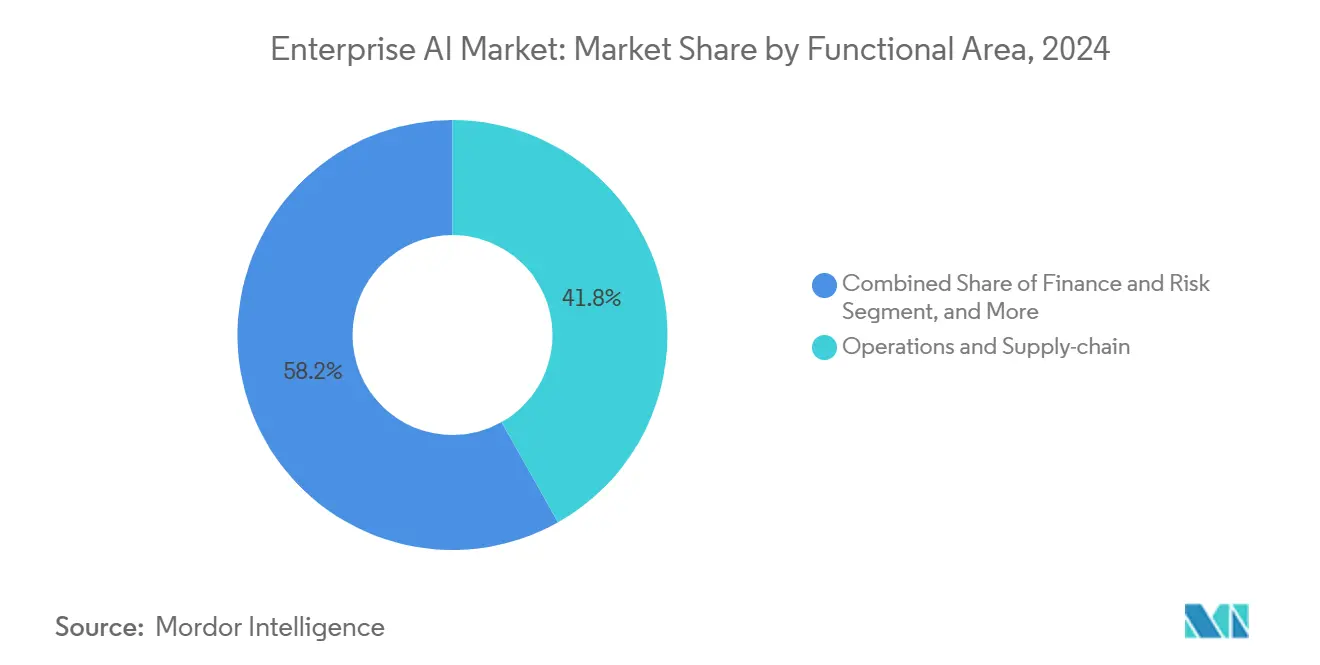
Note: Segment shares of all individual segments available upon report purchase
By Technology: Foundation Models Reshape AI Landscape
Machine learning underpins most deployments, but foundation models are recasting the technology stack. These broad models offer a base that enterprises fine-tune with proprietary data, cutting development cycles. Natural-language interfaces unlock self-service analytics, and multimodal models merge text, vision, and audio for richer insights. As a result, the enterprise AI market observes heightened demand for compute and vector-database storage.
Decision-intelligence layers synthesise predictions, constraints, and optimisation goals into recommended actions. Early adopters combine agentic AI with foundation models to create systems that plan, execute, and self-correct, pointing to further penetration across knowledge-worker tasks.
By End-User Industry: Healthcare Emerges as Growth Leader
BFSI retained 21.30% 2024 share of the enterprise AI market, driven by fraud analytics and personalised banking. Healthcare is the fastest climber at 22.17% CAGR, spurred by AI-enabled image analysis and clinical-decision aids. The enterprise AI market size for healthcare applications is therefore projected to expand sharply through 2030.
Hospitals pilot surgical-navigation systems that cut inpatient stays by 20%, while payers use AI to flag claim anomalies. Manufacturing remains a heavy investor in predictive maintenance, and retailers deploy recommendation engines to boost basket size. Energy operators monitor grid assets with AI to pre-empt faults, broadening cross-sector adoption. [3]Deloitte, “Harnessing gen AI in Financial Services: Why Pioneers Lead,” deloitte.com
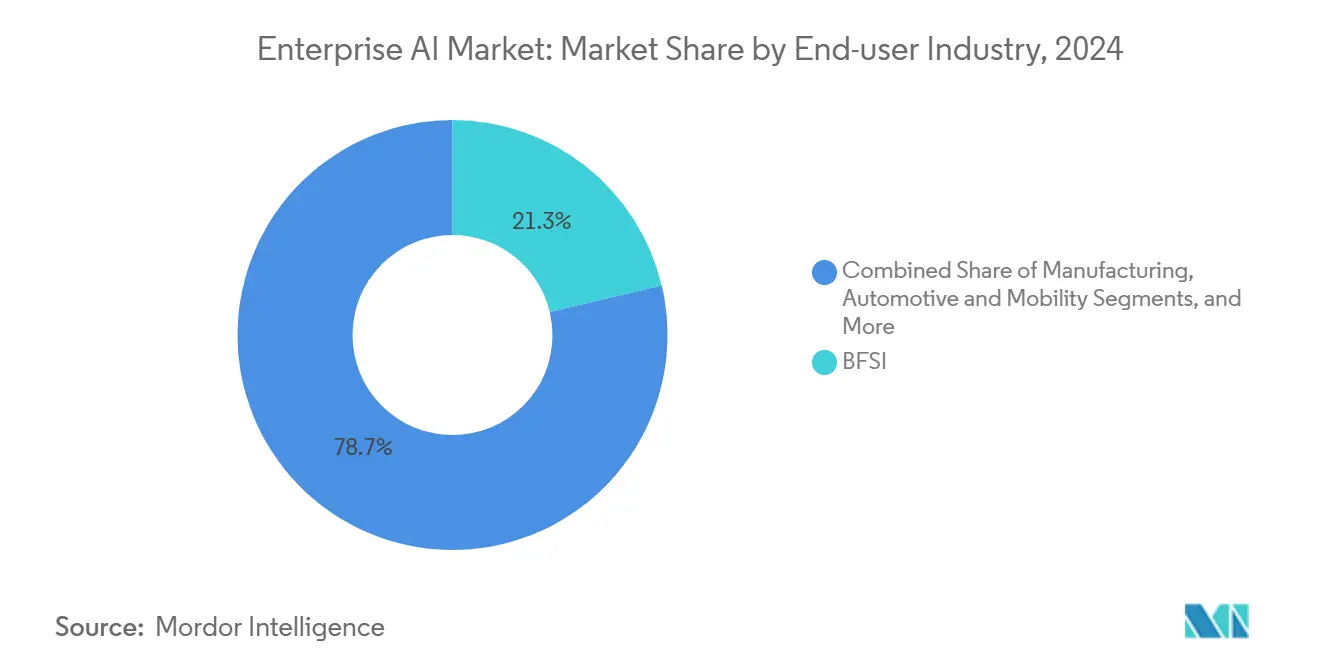
Note: Segment shares of all individual segments available upon report purchase
By Deployment Model: Hybrid Edge Configurations Gain Momentum
Cloud services commanded 69% enterprise AI market share in 2024, reflecting economies of scale and rich tooling. Yet hybrid and edge architectures are pacing the sector at 24.05% CAGR to 2030 as firms need low-latency inference and tighter data control. The enterprise AI market size for hybrid solutions is therefore expanding faster than for pure-cloud options.
Manufacturers deploy edge devices to flag defects in milliseconds, cutting scrap rates and unplanned downtime. Federated learning spreads model training across local nodes, ensuring compliance with regional privacy laws while preserving global accuracy. These patterns suggest that future enterprise AI market growth will hinge on robust orchestration across cloud, edge, and on-prem environments.
Geography Analysis
North America controlled 41.50% of 2024 enterprise AI market revenue, buoyed by hyperscaler capex exceeding USD 75 billion and a deep venture ecosystem. US policy now scrutinises cloud-AI partnerships for anticompetitive lock-ins, yet the innovation engine remains robust. Canada pursues a balanced governance blueprint that preserves research flexibility while safeguarding ethics, and Mexico leverages near-shoring to channel AI investment into manufacturing corridors.
Europe adopts a platform of trust anchored by the EU AI Act, shaping solutions that foreground explainability. Germany’s strong industrial base fuels demand for AI-powered automation, while the UK positions itself as an AI testing sandbox under a pro-innovation stance. French and Italian initiatives combine ethical frameworks with incentives for startup creation, though compliance overhead can lengthen go-to-market cycles.
Asia-Pacific records the fastest uplift in active deployments. China shows 83% generative-AI adoption, yet US firms lead in production-grade rollouts, underscoring maturity gaps. Japan and South Korea scale domestic semiconductor fabs to secure hardware supply, and India’s USD 19 billion AI funding wave accelerates startup momentum. Meanwhile, the Middle East and Africa enterprise AI market is forecast at 21.70% CAGR as sovereign wealth funds bankroll national AI hubs in Saudi Arabia and the UAE. Latin America crafts human-rights-oriented regulations, creating white spaces for responsible-AI platform vendors.
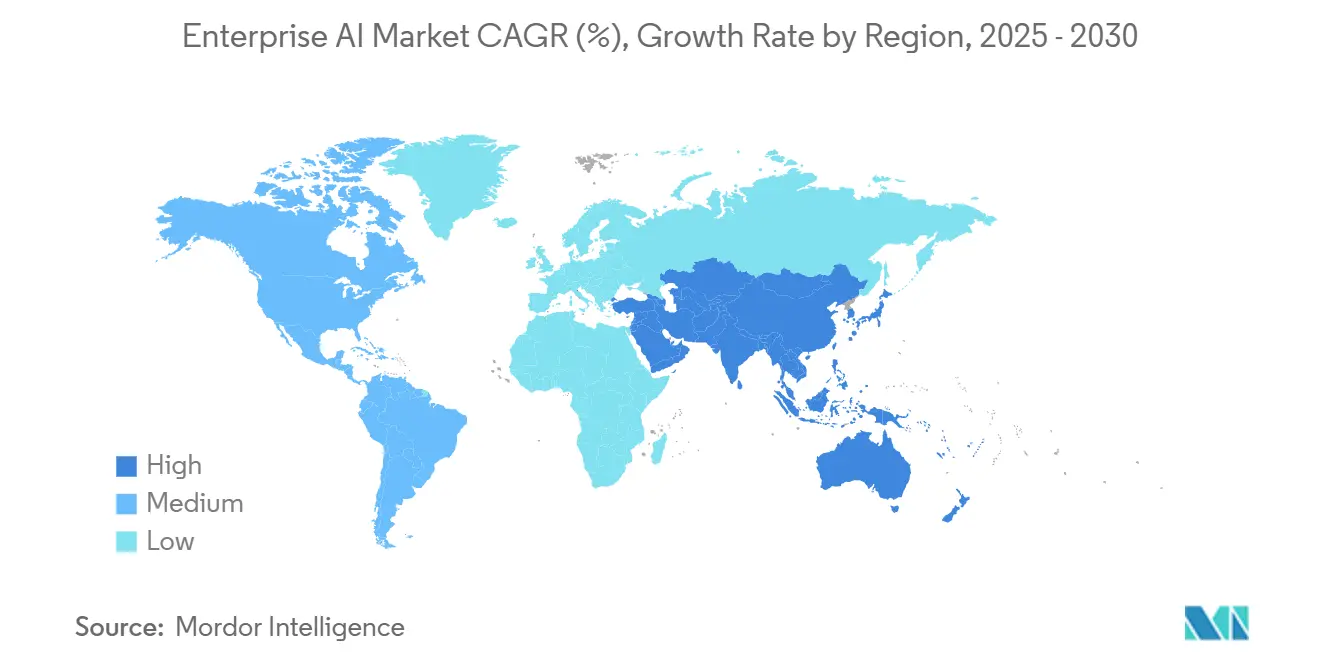
Competitive Landscape
Competition clusters around cloud hyperscale's, diversified enterprise-software players, and AI-native entrants. Microsoft, Amazon, and Google wield integrated stacks from silicon to SaaS, bundling AI into core productivity suites. Oracle and SAP embed large-language models into ERP and CRM workflows, defending installed bases. AI-first specialists such as OpenAI or Anthropic license foundation models to downstream developers, while chip makers vie for share of swelling inference workloads.
Strategic moves skew toward acquisition. IBM’s USD 6.4 billion HashiCorp deal underscores hybrid-cloud orchestration, and ServiceNow spent USD 2.85 billion on Moveworks to embed conversational AI in workflow tools. Edge-focused startups attract attention where low-latency requirements hinder cloud exclusivity. Exclusive GPU supply agreements create high switching costs, prompting antitrust scrutiny.
Industry structure is settling into a platform-plus-ecosystem paradigm: foundational model providers supply core capabilities, systems integrators tailor them, and a long tail of ISVs delivers vertical applications. Partnerships such as Microsoft joining Workday’s Agent Partner Network illustrate coopetition, where rivals interoperate to address multi-agent orchestration needs. [4]RCP Magazine, “Microsoft Joins Workday’s AI Agent Partner Network,” rcpmag.com
Enterprise AI Industry Leaders
-
Microsoft Corporation
-
Amazon Web Services, Inc.
-
International Business Machines Corporation (IBM)
-
Google LLC
-
Oracle Corporation
- *Disclaimer: Major Players sorted in no particular order
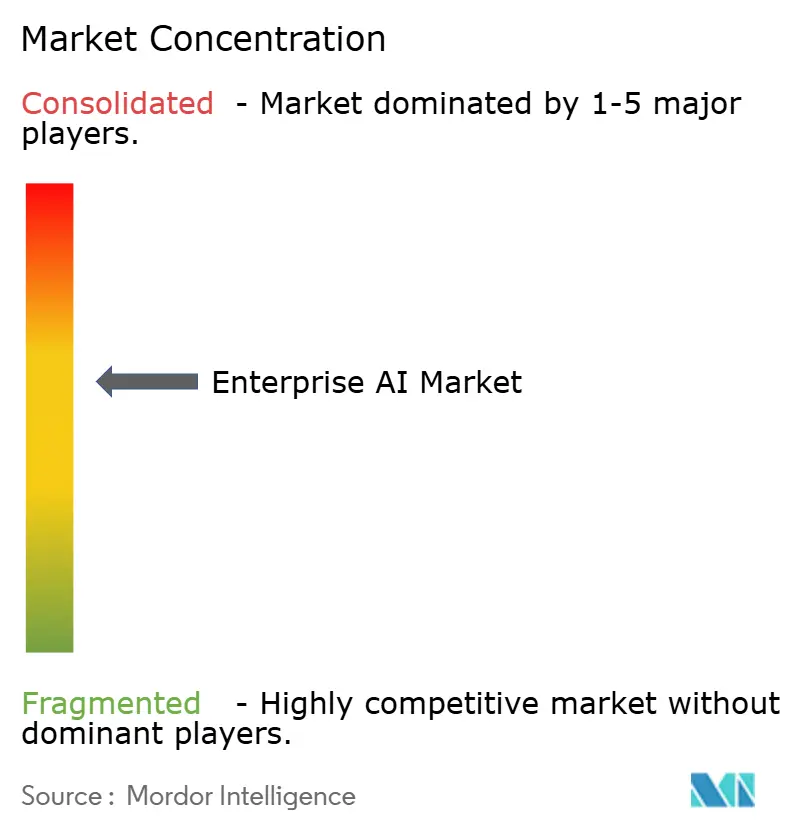
Recent Industry Developments
- June 2025: Microsoft joined Workday’s AI Agent Partner Network to integrate agents across workforce systems, with general availability slated for late 2025.
- June 2025: Google Cloud and OpenAI announced a compute-capacity partnership that diversifies OpenAI beyond Azure and feeds a USD 500 billion multi-cloud infrastructure plan.
- June 2025: IBM acquired Seek AI and launched the USD 500 million Watsonx AI Labs to co-create enterprise applications in security and customer service.
- June 2025: S&P Global closed its purchase of TeraHelix to enhance cross-platform data modelling for AI workflows.
Research Methodology Framework and Report Scope
Market Definitions and Key Coverage
Our study defines the enterprise AI market as all software platforms, supporting hardware accelerators, and related services that embed machine learning, natural-language, vision, or agentic capabilities into core business workflows, from data ingestion through inference, across every major industry vertical.
Scope exclusion: consumer-facing AI apps (e.g., personal assistants, gaming bots) and one-off professional-services projects lie outside this boundary.
Segmentation Overview
- By Component
- Software / Platform
- Services
- Hardware Accelerators
- By Organization Size
- Large Enterprise
- Small and Medium Enterprises
- By Functional Area
- Customer-facing (CX, marketing, sales)
- Operations and Supply-chain
- Finance and Risk
- HR and Talent
- By Technology
- Machine Learning / Foundation Models
- Natural-Language Processing
- Computer Vision
- Decision Intelligence / Optimisation
- By End-user Industry
- BFSI
- Manufacturing
- Automotive and Mobility
- IT and Telecom
- Media and Advertising
- Healthcare and Life-sciences
- Retail and e-Commerce
- Energy and Utilities
- Other End-user Industry
- By Deployment Model
- On-premise
- Cloud
- Hybrid / Edge
- By Geography
- North America
- United States
- Canada
- Mexico
- Europe
- Germany
- United Kingdom
- France
- Russia
- Rest of Europe
- Asia-Pacific
- China
- Japan
- India
- South Korea
- Australia
- Rest of Asia-Pacific
- Middle East and Africa
- Middle East
- Saudi Arabia
- United Arab Emirates
- Rest of Middle East
- Africa
- South Africa
- Egypt
- Rest of Africa
- Middle East
- South America
- Brazil
- Argentina
- Rest of South America
- North America
Detailed Research Methodology and Data Validation
Primary Research
We validate secondary cues through structured interviews with cloud-provider product leads, enterprise-software architects, chief data officers, and systems-integrator executives across North America, Europe, Asia-Pacific, and the Gulf. Surveys of mid-market IT buyers help calibrate spending thresholds and deployment timelines, ensuring assumptions mirror on-ground realities.
Desk Research
Mordor analysts collect foundational signals from publicly available tier-1 sources such as the U.S. Bureau of Labor Statistics, Eurostat, UN Comtrade, and national AI policy portals, complemented by trade bodies like the OECD AI Observatory and the World Semiconductor Trade Statistics program. Company 10-Ks, investor decks, and respected media archives accessed through Dow Jones Factiva enrich adoption and pricing insights. Questel patent analytics and Marklines hardware build-outs add technology-diffusion clues. The sources cited illustrate our process; they are not exhaustive.
Market-Sizing & Forecasting
A top-down construct starts with enterprise IT spending pools, which are then filtered through AI penetration rates by industry and deployment model. Select bottom-up checks, sampled average selling price multiplied by accelerator shipments, and license counts from large SaaS vendors close loopbacks. Key variables include GPU unit ASP trajectories, cloud-AI service usage hours, regulated-sector adoption lags, talent-cost curves, and data-sovereignty mandates. Multivariate regression coupled with three-scenario adjustments (base, high, low) projects growth through 2030, while gap patches in hardware roll-ups are bridged with extrapolated shipment data from customs registries.
Data Validation & Update Cycle
Outputs face variance screens, peer review, and anomaly flags before sign-off. Models refresh every twelve months, with expedited revisions after material events such as abrupt GPU price shifts or blockbuster foundation-model launches.
Why Mordor's Enterprise AI Baseline Is Trusted
Published numbers often diverge because firms choose different inclusion rules, forecasting windows, and currency conversions.
Key gap drivers include: some publishers track only AI-enabled software subscriptions, others omit emerging accelerator hardware or professional-service revenue, and a few apply aggressive CAGR uplifts without reconciling to current IT budget shares. Our disciplined scope, dual-path modelling, and annual refresh cadence limit such drift.
Benchmark comparison
| Market Size | Anonymized source | Primary gap driver |
|---|---|---|
| USD 97.20 B | Mordor Intelligence | - |
| USD 31.51 B | Global Consultancy A | software-only scope and higher base-year discounting |
| USD 28.80 B | Industry Association B | excludes hardware accelerators and uses fixed $/user metric |
These comparisons show that, by aligning spend pools with real adoption ratios and validating through supplier roll-ups, Mordor Intelligence delivers a balanced, transparent starting point that decision-makers can retrace and replicate with confidence.
Key Questions Answered in the Report
What is the current size of the enterprise AI market?
The market was valued at USD 97.2 billion in 2025.
How fast is the enterprise AI market expected to grow?
It is projected to reach USD 229.3 billion by 2030, reflecting an 18.9% CAGR.
Which component segment is growing the quickest?
Hardware accelerators lead growth, expanding at a 23.11% CAGR through 2030 as demand for specialised AI chips rises.
Which deployment model is gaining momentum beyond public cloud?
Hybrid and edge configurations show the highest uptake, advancing at 24.05% CAGR because they balance low-latency processing with data-sovereignty needs.
Which end-user industry will see the fastest AI spending growth?
Healthcare is forecast to grow at 22.17% CAGR, driven by clinical decision support and medical-imaging applications.
What region offers the highest growth potential for enterprise AI?
The Middle East and Africa region is expected to record a 21.70% CAGR, fuelled by sovereign AI programmes and large infrastructure investments.
Page last updated on:
